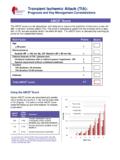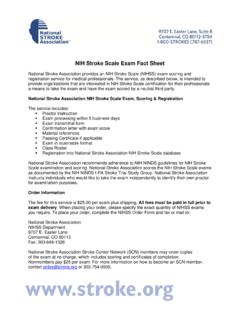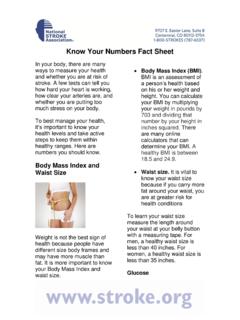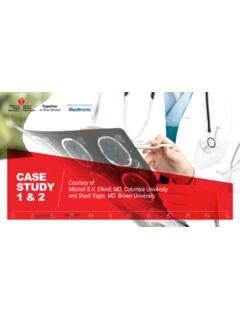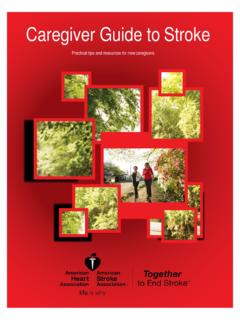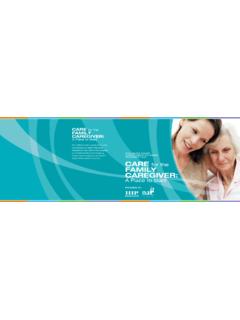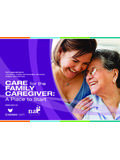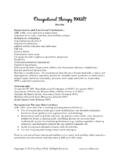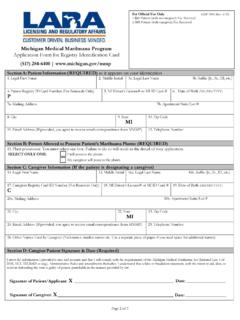Transcription of CHAPTER 6—managing reCoverY - Stroke.org
1 33 National stroke AssociationStroke reCoverY is not a linear process. The stroke survivor s needs may change, and as a caregiver, your role will change along with them. It is helpful to be open to these changes. As the stroke survivor regains strength and independence, your role may lessen, but it may also increase if new challenges arise. Keep open communication with the stroke survivor to make sure you are tuned in to their changing needs and concerns. Over time, you and the stroke survivor may need to re-establish boundaries and figure out new ways to caregivers find that support groups/clubs are helpful in connecting with other caregivers to share advice, stories or tips. National stroke Association has a number of caregiver-focused support groups in its stroke Support Group Registry at and a new online network for caregivers Careliving Community at CHAPTER 6 managing reCoverY34 Careliving guide : Caring for Yourself and a stroke SurvivorHome modifiCationS Home modifications may be necessary depending on the stroke survivor s needs.
2 Making appropriate modifications will enable the stroke survivor to regain independence throughout reCoverY . If facing financial challenges, be creative and seek help with your home modifications from friends, neighbors, faith communities, veterans groups and community organizations. Look for stores and/or websites that sell affordable new/used adaptive equipment and medical supplies. See the Managing Life at Home fact sheet at for more detailed of home adaptation include: Installing ramps that can be built or purchased. Rearranging or removing excess furniture and rugs to avoid falls. Checking lighting to ensure that walkways are well lit and to determine whether current window coverings need to be changed. Modifying the kitchen to ensure safety and accessibility. Checking the stair and wall rails for sturdiness. Installing grab bars, shower chairs and raised toilets in the bathroom. Acquiring medical supplies and assistive living devices ( , gait belts, adaptive cups and utensils and safety monitors to listen to someone in another room).
3 Determining whether an emergency alert device is necessary. Having a key for emergency access. Install a lockbox or leave a key with your neighbor. This avoids the need for personnel to knock down your door in case of emergency. managing reCoverY35 National stroke AssociationreSPite CareThroughout caregiving, remember that you have options. respite care refers to short-term relief services for the stroke survivor so you, the caregiver, can take a break. Caregivers providing unpaid care are eligible for respite care under the 2006 Federal Lifespan and Respite Care Act. Online registries, newspapers and yellow pages can be helpful in finding respite providers, or ask your medical and rehab care team members if they can make a referral. When choosing a respite care provider, it can be helpful to: Screen and interview each respite provider. Ask for work and personal references. Discuss payment in advance.
4 Conduct background checks if is a nonprofit online resource with great tips for picking a respite care provider. Visit their site at Include the stroke survivor in the respite care planning as much as possible. A printable consumer guide to respite care is available at for respite care will be similar to paying for rehab. Not all insurance programs cover respite care but some states use waivers to offset costs. Check the federal government s Administration on Aging ( ) and/or your state s agency on aging ( ) to determine your National Respite Network and Resource Center is an online resource center that connects caregivers and healthcare professionals with local respite services. Visit to find services near you. managing reCoverY36 Careliving guide : Caring for Yourself and a stroke SurvivorPoSt- stroke ConCernSDamage to brain tissue from a stroke can cause a variety of challenges for a stroke survivor.
5 Seek advice and guidance from your medical and rehab care team members on managing the varying effects of the stroke . aPHaSiaaphasia is an impairment of language that affects the ability to use and comprehend words. a common problem for roughly one quarter of stroke survivors, aphasia may make it hard to: Talk. Understand what others say. Read. Write. Use numbers and do calculations. Aphasia affects people in different ways. stroke -related aphasia can improve with speech therapy. Ask your speech therapist for exercises you can do with the stroke survivor. Computer and word games and puzzles will promote improvement (depending on the level of ability, children s learning tools can be very helpful). The webinar iHoPe: aphasia at discusses how aphasia is related to stroke and offers practical management strategies for stroke survivors and caregivers. managing reCoverY37 National stroke AssociationCognition (tHinking)Memory, attention span, self-awareness and comprehension skills may be diminished in a stroke survivor after the stroke .
6 Your loved one may lose the ability to learn new tasks, remember things, problem-solve, understand things, make plans or acknowledge the reality of his/her physical limitations. There are a variety of ways to manage cognitive deficits as well as improve them: Break up tasks into simple steps. Set a routine. Keep things the stroke survivor regularly uses (such as a toothbrush) in the same place. Use prompts and reminders. Repeat exercises. Read. Play card games, memory games, puzzles and crosswords to improve memory, focus and thinking skills. Consult with a speech therapist and/or an occupational therapist for more (limited movement) If the stroke survivor is confined to a bed, move him/her often to protect against bed sores and skin irritations. Range-of-motion exercises and leg lifts will help with muscle strength, and installing bed rails is an essential safety feature. Safety monitors and walkie-talkies can also help you communicate with the stroke survivor when you are in another room.
7 Managing reCoverY38 Careliving guide : Caring for Yourself and a stroke SurvivorinContinenCeIncontinence refers to the inability to control the bladder (urinary incontinence) and/or bowels (fecal incontinence). Incontinence is more common in the early stages post- stroke . Both types of incontinence are characterized by involuntary and physical therapies such as kegel exercises and bladder training, known medically as prompted voiding, includes exercises to help the stroke survivor regain control of his/her bladder and/or bowels. Work with a healthcare professional to set up a voiding schedule, assigning times to use the bathroom. The training involves adhering to the schedule as closely as possible with planning, deep breathing and mental exercises. Adjusting the stroke survivor s diet, disposable undergarments, a bedside commode, catheters and some medications may also help with this. Limited mobility and activity, depression, anxiety, dehydration and diet can lead to constipation.
8 Narcotic medications often cause constipation, which can be aided by the use of stool softeners. For treatment descriptions, management suggestions and available supplies see the Bladder and Bowel Function fact sheet at incontinence issues may be uncomfortable to deal with and/or cause embarrassment, so try to be a nurse conduct an evaluation and assessment will be very helpful in determining individualized strategies. managing reCoverY39 National stroke Associationmeal timeDepending on the stroke survivor, paralysis, one-sided weakness and/or dysphagia (trouble swallowing) can make feeding oneself difficult. Pay close attention to breathing and swallowing issues to avoid choking. Paralysis can also make it difficult for the stroke survivor to feed him/herself. Here are some suggested meal-time aids: Adaptive utensils with foam handles/grips. Plate guards. Cups with handles. Liquid adHerenCe and ComPlianCeMedication adherence is a prevalent issue surrounding recurrent stroke prevention.
9 Many patients report not taking their medications exactly as prescribed. Additionally, 50 percent of aging patients on multiple prescription medications admit that they forget to take their medications at varying degrees, with some patients habitually missing their medications. Taking medications as prescribed is central to reCoverY post- stroke and recurrent stroke reCoverY40 Careliving guide : Caring for Yourself and a stroke SurvivorQuestions to ask the prescribing healthcare professional and/or pharmacist: What is the medicine s name and what is it for? When and how should the medicine be taken?What are the possible side effects?When should I expect the medicine to start working?Will the medicine interact with any of the stroke survivor s other medicines?Is it okay to take this with supplements ( , vitamins or omega-3s)?What should the medicine look like?What do I do if the stroke survivor forgets a dose?
10 What are the repercussions if the stroke survivor stops taking it altogether?Besides time of day, is there any other thing I should know about the stroke survivor taking the medications ( , on a full stomach or with milk)?Are there foods to avoid?Taking so many medications can become expensive. Many medications are available in generic form; you and the stroke survivor should talk to the prescribing healthcare professional about available options. There are also a number of patient assistance programs that can help with payment. Visit to learn about medication adherence and for links to the patient assistance to take medications can also cause issues with compliance. Many people find medication organizers, home delivery, auto-refills, numbering medications, medications trackers, pill boxes or alarms useful. See Appendix E for a Medication Tracker Template. Watch and listen to iHoPe: medication adherence and Compliance, a webinar that provides strategies and tips for effectively managing medications.


